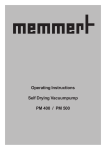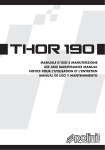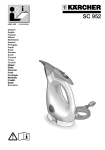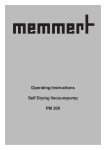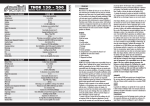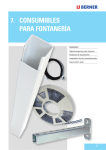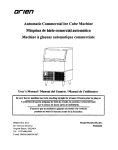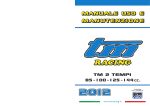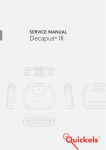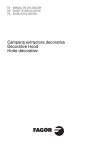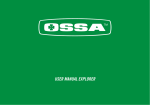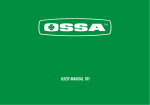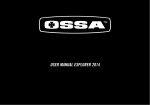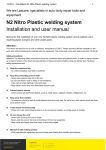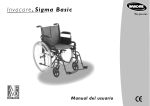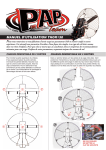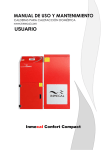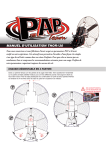Download THOR 100 MANUALE D`USO E MANUTENZIONE
Transcript
THOR 100 19 MANUALE D’USO E MANUTENZIONE - USE AND MAINTENANCE MANUAL 270,5 66,3° 65 54 Ø25 216 50 85 /on Ø 6 su n.6 M 325 295 M8X4 holes Ø30 85 40 202 asse elica propeller axis 240 125 PI 415 125 125 125 5 4 01 02 11 12 03 04 13 14 1 2 Livello olio Oil level ITALIANO 05 06 15 16 07 08 17 18 09 10 19 20 ITALIANO 7 6 21 22 23 24 25 27 C 28 E B D A OPTIONAL 29 ITALIANO 26 30 ITALIANO PREMESSA Complimenti per aver acquistato un motore Polini. Con questa scelta siete entrati a far parte di una distinta famiglia di possessori di un prodotto che vi darà grandi soddisfazioni THOR è stato progettato in modo da garantire le migliori prestazioni possibili. Vi raccomandiamo di leggere attentamente il presente manuale d’uso e manutenzione prima di utilizzare il vostro nuovo motore. Questo libretto contiene informazioni importanti che vi aiuteranno ad ottenere il massimo della soddisfazione che l’utilizzo del motore Thor 100 può regalarvi. La perfetta messa a punto e la totale conoscenza del vostro motore assicura sicurezza e tranquillità durante il suo utilizzo. INDICE 1- AVVERTENZE GENERALI 2- CARBURANTE 3- MESSA IN MOTO 4- RODAGGIO 5- SPEGNIMENTO DEL MOTORE 6- CONTROLLO CARBURAZIONE 7- PULIZIA 8- TRASPORTO 9- MANUTENZIONE ORDINARIA 10- MANUTENZIONI STRAORDINARIE 11- INSTALLAZIONE DEL MOTORE SUL TELAIO 12- TABELLE MANUTENZIONI 13- DIAGNOSI DIFETTI 1- AVVERTENZE GENERALI La Polini ed il distributore declinano ogni responsabilità diretta o indiretta legata all’uso del proprio motore, soprattutto nel caso in cui il motore venga ritoccato o manomesso da terzi. La Polini non si assume la responsabilità di danni causati dalla scarsa manutenzione o dall’errato montaggio, escludendo la sostituzione dei pezzi dalla garanzia. Eventuali modifiche tecniche potranno essere apportate dall’acquirente, che si assume tutta la responsabilità di eventuali danni; i pezzi di ricambio a scopo di modifica non sono coperti dalla garanzia. Si avverte che ogni modifica al motore apportata dall’acquirente o la rimozione di parti originali possono rendere il motore pericoloso! L’utente è invitato a rispettare ed attenersi a quanto indicato e consigliato nel manuale d’uso e manutenzione per l’incolumità propria e di terzi. L’utilizzo che viene fatto di questo motore è molto rischioso, quindi bisogna avere la massima attenzione prima, durante e dopo il volo, per non incorrere in incidenti molto gravi. Vi invitiamo pertanto ad essere accorti, in modo da prevenire incidenti e danni ed a tenere sempre presente che: - il motore non può risolvere tutti i problemi di volo; bisogna pertanto evitare manovre poco sicure. Uno degli errori più comuni è quello di sorvolare zone in cui non è possibile atterrare. Bisogna sempre considerare l’eventualità di un‘avaria e la necessità di effettuare un atterraggio di emergenza. E’ fatto divieto sorvolare centri abitati, agglomerati di case ed assembramenti di persone, nonché il lancio di oggetti o liquidi in volo. -la mancanza di spinta del motore può creare disturbi alla stabilità del volo: il motore potrebbe spegnersi in qualsiasi momento e potreste essere costretti a fare un atterraggio di emergenza in una zona sicura. Prima di ogni utilizzo, per la propria incolumità e quella di terzi, è opportuno accertare che le condizioni climatiche ed atmosferiche siano buone e comunque adeguate per un volo sicuro, anche al fine di non pregiudicare il buon funzionamento del motore. La pioggia o le condizioni climatiche avverse, oltre che fonte di rischio, potrebbero, infatti, determinare danni al motore e comprometterne il regolare funzionamento. Non è consentito utilizzare il paramotore in condizioni di pioggia e forte vento. Volate solo se la velocità del vento, la direzione e le condizioni meteo garantiscono un volo in sicurezza. E’ importante accertarsi delle previsioni meteo delle ore prossime al volo, nonché avere accortezza e conoscenza della zona di decollo e di atterraggio. A causa dei rischi insiti nell’uso del paramotore, e quindi del volo, la Polini non concede nessuna garanzia contro incidenti, rotture, ferite o morte. Volare con il paramotore richiede sempre la massima attenzione. Siate consapevoli che volate a vostro rischio. Prima di ogni utilizzo controllate le buone condizioni del paramotore. Questo motore non è coperto da alcuna assicurazione di responsabilità. L’uso dello stesso determina automaticamente l’assunzione di tutti i rischi inerenti lo sport del paramotore e la personale responsabilità verso danni propri o a terzi, incidenti, ferite o morte, derivanti dall’uso di questo prodotto. Si invita pertanto a leggere attentamente le istruzioni contenute in questo manuale, in quanto utili per una maggiore conoscenza del prodotto e padronanza dello stesso e dunque utili a prevenire e misurare eventuali rischi. Garanzia Tutti i motori Polini sono costruiti con materiale di qualità per cui si garantisce che il prodotto acquistato è privo di difetti, a condizione che l’acquirente acquisti il prodotto da un concessionario autorizzato Polini. Durata La garanzia ha una durata di 24 mesi decorrenti dalla data di vendita all'utente finale. E' necessario attivare la garanzia con l'apposito modulo e conservare lo scontrino fiscale o la fattura. Copertura La presente garanzia copre i danni del motore causati da componenti difettosi per forma o materiale, per progettazione non conITALIANO 9 8 forme all’utilizzo indicato, assemblaggio non corretto da parte della casa costruttrice. La Garanzia comprende pezzi di ricambio e manodopera. Sono esclusi dalla garanzia i costi di trasporto, che saranno a carico dell’utente. Sono esclusi dalla garanzia i danni derivanti da: - modifiche al motore non approvate dalla Polini - normale logorio o usura dei componenti - negligenza, mancanza di manutenzione, incidenti, installazione o manutenzione non corrette; - cadute accidentali o caduta del motore o dei suoi componenti; - un utilizzo improprio o dal maltrattamento del motore; - uso di accessori o componenti non indicati nell’utilizzo del motore; - surriscaldamento o fermo del motore a causa dell’uso prolungato, oltre il termine consigliato dalla Polini; - mancata o regolare manutenzione del motore come indicato dalla Polini, uso di carburanti o lubrificanti non adatti, presenza di sporcizia o di corpi estranei nel motore, anche aspirati; - affaticamento del motore per utilizzo di carichi eccessivi; - deterioramento del motore o di parte di esso per custodia in luoghi non idonei; - assemblaggio non corretto del motore, compreso l’uso di componenti non originali Polini e comunque di proprietà di terzi; - danni al motore derivanti da oggetti esterni; - interventi di manutenzione da parte di soggetti diversi dalla Polini o da soggetti non autorizzati dalla Polini; - utilizzo del motore per competizioni. Adempimenti da parte dell’utente finale Ogni reclamo dovrà essere effettuato consegnando il prodotto da ispezionare ad un concessionario Polini autorizzato. L’acquirente dovrà fornire la copia della “prova di acquisto” in originale o del tagliando di garanzia regolarmente vidimato dalla Polini o dal distributore. Per conservare la validità della garanzia il cliente deve effettuare le manutenzioni periodiche previste dal manuale di uso e manutenzione. Limitazioni di responsabilità Conformemente a quanto stipulato nella presente garanzia, gli obblighi della Polini saranno limitati alla riparazione del componente difettoso o, a discrezione, alla sostituzione di uno o più componenti, secondo quanto sarà ritenuto necessario per porre rimedio ad ogni malfunzionamento dovuto ai difetti di materiale o di manodopera coperti dalla garanzia. Alcuna responsabilità può essere imputata alla Polini o al distributore del motore per ogni problema o danno recato a persone/cose/animali riscontrato durante tutta la vita del motore. Ricordiamo che questo prodotto non è certificato ed è dedicato a velivoli sperimentali e che in qualsiasi momento può rompersi o smettere di funzionare. Pertanto non sono coperti né da garanzia né da risarcimento i danni causati: - a persone/animali/cose causati dall’utilizzo generico del motore. - a persone/animali/cose causati da una collisione con l’elica o ITALIANO una qualsiasi parte staccatasi dal motore. - al telaio, componenti del velivolo e/o all’elica causati dalla collisione con una qualsiasi parte proveniente dal motore. - spese di recupero, di spedizione, telefoniche o di noleggio di qualsiasi tipo, inconvenienti o perdite di tempo, o altri danni indiretti. Pericolo! Questo motore, non certificato, può spegnersi di colpo. L'interruzione del motore può provocare atterraggi di fortuna che possono produrre ferite o portare alla morte. Il velivolo spinto da questo motore dovrebbe volare soltanto negli spazi aperti e negli orari di luce. L'acquirente si assume tutto il rischio per l’uso ed è consapevole che durante il suo utilizzo questo motore si potrebbe spegnere di colpo. Questo prodotto non è coperto da responsabilità civile prodotti. Chi vola con il paramotore o semplicemente lo accende si assume tutti i rischi inerenti lo sport del parapendio a motore ed ogni responsabilità per danni a cose e a persone, o decesso causato dall’uso di questo prodotto. 2- CARBURANTE Il thor 100 è un motore a 2 tempi che necessita di una miscela di benzina e olio. Utilizzare solo benzina verde acquistata al distributore con un numero di ottani compreso tra 95 e 98 di buona qualità. Addizionare la benzina con olio sintetico di buona qualità al 2% . E’ possibile utilizzare una miscela con olio al 1,5% utilizzando i seguenti oli: MOTUL 800 - CASTROL 242 - BARDAL KXT - ELF 976 – ELF 909. Esistono in commercio benzine con un basso potere antidetonante che potrebbero creare grossi problemi di autoaccensione con relativo sfondamento del pistone o grippaggio. Prima del decollo provare sotto carico a motore caldo dai 7000/7500 giri: si potrebbero creare dei forti battiti in testa causando un rumore metallico. In questo caso controllare la carburazione attraverso la candela che muta dal colore naturale nocciola ad un grigio con incrostazioni appuntite. Se persistono i problemi sostituire tutta la miscela cambiando il fornitore e verificare nuovamente la carburazione. AVVERTENZA: il tipo di incrostazioni carboniose depositate sulla testa, sulla candela e sullo scarico del cilindro sono informazioni che indicano il tipo di miscelazione del vostro motore. Si rammenta che una combustione troppo ricca d’olio non allunga la durata del motore. ATTENZIONE: la benzina è estremamente infiammabile ed esplosiva. Eseguire queste operazioni in un luogo ben ventilato e a motore spento. Non fumare, non provocare scintille o fiamme nell’area in cui la benzina viene conservata e dove avviene il rifornimento. 3- MESSA IN MOTO Avviare il motore solo dopo essersi accertati che sia tutto in ordine e perfettamente funzionante. Verificare inoltre il corretto serraggio della bulloneria. Primo avviamento a freddo: riempire il circuito di alimentazione carburante utilizzando l’apposita pompetta (attenersi alle indicazioni del costruttore del telaio per l’individuazione ed il corretto utilizzo di quest’ultima).Per facilitare l’operazione premere delicatamente con un dito la membrana del carburatore attraverso l’apposito foro indicato dalla freccia in foto 1 (non utilizzare oggetti appuntiti che potrebbero rovinare la membrana compromettendone il corretto funzionamento). Il riempimento va eseguito fino a quando non si vede arrivare la benzina al carburatore. Quando ciò avviene fermarsi immediatamente; se si continua ad agire sulla pompetta il carburante tende a filtrare all’interno provocando l’ingolfamento del motore. Posizionare la levetta dello starter in posizione chiusa (foto 1): a questo punto impugnare l’avviatore ed iniziare a tendere la fune fino a quando non si indurisce. Tirare dunque con forza e decisione senza accelerare fino a quando il motore prova ad accendersi (non ripetere questa operazione più di 3 volte altrimenti il motore potrebbe ingolfarsi), a questo punto è necessario riposizionare la levetta dello starter in posizione aperta (foto 2) ed agire nuovamente sulla corda di avviamento senza accelerare. Se il motore non dovesse avviarsi con i primi due colpi riprovare accelerando leggermente. ATTENZIONE: Durante tutte le fasi tenere sempre in mano l’interruttore di spegnimento e tenersi pronti ad azionarlo in qualsiasi caso di anomalia. Nel qual caso tenerlo premuto fino a completo spegnimento del motore. Una volta avviato il motore consigliamo di fare un test di corretto funzionamento del pulsante di spegnimento. Dopo il controllo riavviare il motore senza accelerare e senza l’utilizzo dello starter. A questo punto lasciar girare al minimo il motore dando delle leggere accelerate fino a portare il motore in temperatura. 4- RODAGGIO Per ottimizzare l’assestamento del motore e della trasmissione al primo funzionamento, preservando così da subito l’affidabilità, è indispensabile un breve rodaggio. Attenersi pertanto alle seguenti indicazioni: una volta avviato il motore farlo girare al minimo dando delle leggere accelerate fino al raggiungimento della normale temperatura di esercizio. Consigliamo 15 minuti di avviamento motore a medio-bassa erogazione di potenza del motore dando delle accelerate leggere e di diversa intensità. A questo punto consigliamo di verificare la corretta taratura del minimo (paragrafo 10.1). Durante il primo volo o comunque per i primi 20 litri di carburante consigliamo di non tenere il motore al massimo dei giri per troppo tempo, tenendo presente che il motore a 2 tempi mal sopporta i regimi di rotazione costanti anche se a media potenza. Consigliamo dunque di cercare di variare il regime di rotazione del motore. Dopo il primo atterraggio consigliamo di controllare la carburazione (paragrafo 6). Ripetere il ciclo di rodaggio ogni volta che viene sostituito uno qualsiasi dei seguenti particolari: pistone, fasce elastiche, cilindro, albero motore o i cuscinetti di banco. 5- SPEGNIMENTO DEL MOTORE Per spegnere il motore azionare l’apposito pulsante fino a completo spegnimento (riferirsi alle indicazione del costruttore del telaio per individuare la posizione del pulsante). 6- CONTROLLO CARBURAZIONE Per una corretta analisi della carburazione spegnere il motore subito dopo averlo fatto funzionare per alcuni minuti sotto carico. Togliere la candela svitandola con apposita chiave e verificare il colore della porcellana, che deve essere di colore nocciola. In caso contrario rivolgersi ad un centro autorizzato per la regolazione. 7- PULIZIA Effettuare la pulizia del motore solo a motore spento e freddo per evitare pericoli di scottature. Pulire il motore utilizzando un panno morbido imbevuto di prodotti neutri e non aggressivi. AVVERTENZA: Non utilizzare acidi che potrebbero rovinare il motore. 8- TRASPORTO ATTENZIONE: Effettuare il trasporto solo quando il motore è freddo. Se, per necessità di trasporto, il motore viene posizionato orizzontalmente tappare il raccordo di sfiato del riduttore per evitare la fuoriuscita dell’olio (foto3). Riferirsi alle indicazioni del costruttore del telaio per un corretto trasporto. Porre molta attenzione al carburante durante il trasporto: una fuoriuscita dello stesso può causare un incendio. 9- MANUTENZIONE ORDINARIA ATTENZIONE: LE OPERAZIONI DI MANUTENZIONE DEVONO ESSERE EFFETTUATE ESCLUSIVAMENTE DA PERSONALE COMPETENTE. QUALORA LE OPERAZIONI INDICATE NEI SUCCESSIVI PUNTI DEL MANUALE NON FOSSERO CHIARE ALL’UTENTE, SI CONSIGLIA DI CONSULTARE PERSONALE SPECIALIZZATO PRESSO I RIVENDITORI O CONCESSIONARI POLINI MOTORI. ATTENERSI SCRUPOLOSAMENTE A QUANTO INDICATO NEI SUCCESSIVI PUNTI DEL MANUALE. Le manutenzioni e gli interventi necessari per una messa a punto ottimale del veicolo sono da intendersi come controlli quotidiani di prima messa in moto del veicolo. Manutenzioni e regolazioni quotidiane sono facilmente eseguibili se fatte con le istruzioni dettate da questo manuale d’assistenza. Le manutenzioni straordinarie ITALIANO 11 10 sono dirottate presso i concessionari POLINI MOTORI che sostituiranno i particolari deteriorati esclusivamente con ricambi originali. La frequenza della manutenzione ed il tipo d’intervento sono dettati dal paragrafo 12. 9.1- RIMOZIONE E PULIZIA DEL FILTRO ARIA Un filtro aria sporco può compromettere le prestazioni del veicolo. Provvedere periodicamente alla sua pulizia o eventuale sostituzione. Smontare il filtro allentando la fascetta, svitare le 4 viti utilizzando un cacciavite a croce, rimuovere il coperchio del filtro ed il filtro stesso. Lavare il materiale filtrante in acqua calda con sapone neutro. Far asciugare accuratamente e successivamente umidificarlo con idoneo olio per filtri. Pulire con un panno l’interno della scatola filtri assicurandosi che non vi siano corpi estranei. A questo punto rimontare il tutto facendo attenzione a riposizionare correttamente le 4 barrette che mantengono il filtro in posizione e riavvitare le 4 viti. Un filtro può essere lavato 2-3 volte dopodiché va sostituito con uno nuovo. AVVERTENZA: Nel caso il filtro presentasse una forte concentrazione di polvere o impurità sostituirlo con uno nuovo AVVERTENZA: La mancata pulizia del filtro soffoca il motore riducendone le prestazioni. Un filtro deteriorato può invece facilitare l’immissione nel motore di particelle di polvere accelerando il normale deterioramento di fasce, pistone e cilindro. 9.2- CONTROLLO LIVELLO OLIO RIDUTTORE (vedi anche paragrafo 11.4) Effettuare queste operazioni a motore freddo. Mantenendo il motore in posizione verticale togliere la vite di livello olio sul carter trasmissione (foto4). Verificare che il livello dell’olio sfiori il bordo inferiore del foro. Nel caso vi fosse olio in eccesso lasciare che esso fluisca dal foro di controllo raccogliendo l’olio in eccesso con una bacinella per evitare che si disperda nell’ambiente. Se l’olio non è a livello procedere al riempimento attraverso il raccordo di sfiato posto nella parte alta (foto3). Dopo aver eseguito il controllo, stringere saldamente la vite. Utilizzare olio trasmissioni che soddisfi la specifica API-GL4. 9.3- SOSTITUZIONE OLIO RIDUTTORE Effettuare il cambio dell’olio a motore freddo. Svitare l’apposita vite posta nella parte inferiore del gruppo riduzione/frizione. Raccogliere l’olio che ne fuoriesce in un contenitore. Attendere che tutto l’olio all’interno fuoriesca ed eventualmente inclinare leggermente il motore per facilitare l’operazione. Riavvitare saldamente la vite. Svitare il raccordo/sfiato posto nella parte superiore del carter ed inserire 25 cc di olio tipo API-GL4. Riposizionare il raccordo ed il relativo tubo. AVVERTENZA: Non disperdere l’olio esausto nell’ambiente ma consegnarlo agli enti designati per lo smaltimento. ITALIANO 9.4- SOSTITUZIONE CORDA AVVIATORE Rimuovere l’avviatore dal motore svitando le 4 viti (foto5). Rimuovere il vecchio cordino. Fare attezione perché la ruota centrale ruoterà fino a completo scaricamento della molla; trattenerla e farla scaricare lentamente in modo da evitare danni e pericolo di farsi male. Preparare il cordino nuovo facendo un nodo ad un capo dello stesso. Una volta completamente rimosso il vecchio cordino, trattenendo con una mano la parte esterna far ruotare la parte interna in senso antiorario di 5 giri (foto 6). Fermare la rotazione quando il foro nella ruota interna si trova in corrispondenza del foro sulla parte esterna (foto7). A questo punto prendere il nuovo cordino ed infilare in entrambi i fori contemporaneamente il capo non annodato del cordino (foto7) e far passare completamente la fune fino a quando il nodo va in battuta (foto8). Facendo ben attenzione a non mollare il cordino, lasciare che la molla ritragga autonomamente il cordino avvongendolo sulla ruota interna. Ora far passare il capo libero del cordino attraverso la maniglia ed effettuare un nodo doppio (foto9). Rimontare l’avviatore sul motore riavvitando le 4 viti M5 con la necessaria forza (vedi tabelle serraggi). 9.5- SOSTITUZIONE MEMBRANE CARBURATORE Rimuovere il filtro svitando con un cacciavite a croce la fascetta. Dopo aver rimosso dal carburatore il cavo dell’acceleratore, la molla supplementare, il tubo del carburante ed il tubo del depressore, svitare le due viti a brugola e rimuovere il carburatore dal motore. Posizionarsi su un piano liscio e pulito. Rimuovere il coperchietto superiore svitando le 4 viti (foto10), rimuovere la membrana e la guarnizione, verificare la pulizia all’interno e rimontare utilizzando la membrana nuova e la guarnizione nuova (foto 11). ATTENZIONE: Il carburatore è composto da numerose parti molto piccole e molto delicate. Porre molta attenzione in ogni fase con particolare cura allo spillo e la relativa molla; questi ultimi non vanno toccati . Rimuovere il coperchietto inferiore svitando le 4 viti (foto12), rimuovere la membrana e la guarnizione, verificare la pulizia all’interno con particolare attenzione al filtrino (foto13) e rimontare utilizzando la membrana nuova e la guarnizione nuova. Rimontare il carburatore seguendo il procedimento inverso, facendo ben attenzione a posizionare correttamente tutte le guarnizioni. 10- MANUTENZIONI STRAORDINARIE Premessa: la successiva sezione contiene nozioni necessarie per eventuali tarature e riparazioni. E’ stato realizzato secondo la più recente evoluzione di questa serie. Ci riserviamo comunque il diritto di apportare modifiche migliorative senza obbligo di aggiornamento del manuale stesso. Il manuale non contiene istruzioni riguardanti lavori generali che vengono eseguiti in officina, né un elenco di regole per la sicurezza da rispettare in officina. Si dà per scontato infatti che le riparazioni vengano effettuate da personale specializzato. 10.1- REGOLAZIONE MINIMO AVVERTENZA: Queste regolazioni devono essere effettuate solamente da personale competente. Il motore viene consegnato già regolato. Particolari condizioni atmosferiche o differenze di altitudini possono richiedere una ulteriore piccola taratura del minimo. Il carburatore ha due viti per la regolazione del minimo (foto 14). La vite 1 regola il flusso di benzina al minimo, la vite 2 regola l’apertura della farfalla al minimo (quest’ultima viene detta anche minimo meccanico). La taratura standard della vite 1 si ottiene avvitando del tutto la vite e fermandosi immediatamente appena si sente resistenza. Da questa posizione bisogna svitare la vite di un giro e un ulteriore quarto di giro. Partendo dalla taratura standard si agisce poi sulle due viti per affinare la regolazione. Il regime di rotazione consigliato per il minimo è di 1600-1800 rpm. 10.2- VERIFICA/SOSTITUZIONE PACCO LAMELLARE Rimuovere il filtro svitando con un cacciavite a croce la fascetta. Dopo aver rimosso dal carburatore il cavo dell’acceleratore, la molla supplementare, il tubo del carburante ed il tubo del depressore, svitare le due viti a brugola e rimuovere il carburatore dal motore. Svitare le 4 viti a brugola del collettore e rimuovere lo stesso. Estrarre il pacco lamellare e verificare che le lamelle siano in buone condizioni e che la chiusura delle stessa sia perfetta. In caso contrario sostituirle o sostituire l’intero pacco lamellare. Rimontare il tutto seguendo il procedimento inverso, facendo ben attenzione a posizionare correttamente tutte le guarnizioni. 10.3- MANUTENZIONE IMPIANTO DI SCARICO Rimuovere il cavo di sicurezza controllandone la posizione in modo da essere in grado successivamente di rimontarlo correttamente. Rimuovere le molle utilizzando l’apposito attrezzo (foto 15). Svitare le due viti che tengono la marmitta e rimuovere la stessa dal motore. Non è necessario rimuovere il collettore dal cilindro. Svitare le due viti che trattengono il silenziatore e rimuoverlo dal corpo marmitta. Utilizzando un trapano con una punta diametro 5 mm, rimuovere i rivetti dal silenziatore e togliere i due coperchi. Rimuovere il materiale fonoassorbente e gettarlo. Pulire il tubo traforato dalle incrostazioni e dai residui ed avvolgerelo con il materiale fonoassorbente nuovo. Questo deve essere ben schiacciato. Rimontare il tutto e bloccare con nuovi rivetti in acciaio inox. Pulire la marmitta, rimontare il silenziatore sostituendo i gommini antivibranti. Rimontare l’intera marmitta sostituendo i supporti antivibranti e mettendo del grasso grafitato per alte temperature sull’innesto sostituendo i due O-ring. Verificare lo stato delle molle ed eventualmente sostituirle. Riposizionare il cavetto di sicurezza facendolo passare attraverso le molle e gli appositi fori sui prigionieri e bloccarlo su se stesso (foto 15). ATTENZIONE: Utilizzare della pasta frena filetti su tutte le viti durante il montaggio. 10.4- SMONTAGGIO VOLANO ACCENSIONE Rimuovere l’avviatore, entrambe le parti del convogliatore aria e la ventola. Per svitare il dado centrale del volano, tenere fermo lo stesso utilizzando l’idoneo attrezzo posizionato nei due fori del volano (foto16). Per rimuovere il volano è necessario utilizzare l’estrattore cod. 928.695.002 (foto 17). Avvitare le 3 viti posizionando i 3 distanziali tra l’estrattore ed il volano. Consigliamo l’uso di una pistola ad aria compressa per avvitare la vite centrale dell’estrattore. 10.5- VERIFICA ACCENSIONE E BOBINA Per capire in modo sommario se l’accensione o la bobina hanno problemi si possono effettuare le seguenti verifiche sulle resistenze mediante l’uso di un tester. Accensione: misurando tra filo rosso/nero e filo blu si devono leggere valori compresi tra 200 e 500 OHM. Misurando tra filo rosso/bianco e filo blu si devono leggere valori compresi tra 1 e 20 OHM. Bobina: misurando tra filo il cavo candela e filo nero si devono leggere valori compresi tra 3500 e 7000 OHM. 10.6- MONTAGGIO VOLANO ACCENSIONE Verificare che la chiavetta sia posizionata correttamente sull’albero motore ed inserire il volano innestandolo correttamente. Avvitare la vite centrale e bloccarla utilizzando una chiave dinamometrica (vedi tabella coppie di serraggio). Per evitare la rotazione del volano è necessario utilizzare l’idoneo attrezzo posizionato nei due fori del volano (foto 16). Rimontare la ventola avvitando le 4 colonnette (utilizzare del frena filetti medio) e posizionare le 2 piastrine una sopra l’altra, facendo ben attenzione al verso dei denti di innesto (foto 18). 10.7- SMONTAGGIO FRIZIONE-RIDUTTORE Togliere il supporto elica svitando la vite centrale (foto 19). Svuotare l’olio del gruppo trasmissione, svitando la vite posta nella parte inferiore. Togliere le 8 viti del carter e rimuovere lo stesso. Svitare la vite centrale della frizione utilizzando, per tenerla ferma, l’apposito attrezzo cod. 144.695.006 (foto 20). Per rimuovere la frizione è necessario utilizzare l’apposito estrattore cod. 144.695.004 avvitando le 3 viti; avvitare la vite centrale eventualmente aiutandosi con un cacciavite per evitarne la rotazione (foto 21). Fare attenzione a non perdere la chiavetta posta nell’apposita sede sull’albero. A questo punto è possibile rimuovere la campana e l’albero riduttore. ITALIANO 13 12 10.8- MONTAGGIO FRIZIONE-RIDUTTORE Verificare lo stato di usura delle 2 gabbie rulli ed eventualmente sostituirle (foto 22). Posizionare nel cuscinetto superiore l’alberino riduttore e infilare la campana sulle gabbie rulli. Posizionare la molla a tazza sull’albero con la parte convessa rivolta verso il motore (si consiglia di sostituire la molla a tazza ogni volta che viene smontata). Posizionare la chiavetta nell’apposita sede sull’albero motore e infilare la frizione. Avvitare la vite centrale e bloccarla utilizzando una chiave dinamometrica (vedi tabella coppie di serraggio) e apposito attrezzo (foto 20). Rimontare il coperchio verificando la presenza delle 2 spine di centraggio. Sostituendo la guarnizione con una nuova, bloccare le 8 viti (vedi tabella coppie di serraggio) utilizzando del frena filetti medio. Posizionare sull’albero l’O-RING e successivamente la bussola con lo smusso interno rivolto verso l’O-RING (foto 23). Rimontare la flangia supporto elica e chiuderla utilizzando una chiave dinamometrica (vedi tabella coppie di serraggio). 10.9- SMONTAGGIO GRUPPO TERMICO Smontare l’avviatore e successivamente rimuovere entrambe le parti del convogliatore aria. Smontare l’impianto di scarico (paragrafo 10.3). Svitare i 4 dadi della testa e rimuovere testa e cilindro. Procedere alla manutenzione o alla sostituzione delle parti interessate. Eseguire un’accurata pulizia della testa togliendo eventuali incrostazioni carboniose e pulire il forellino di decompressione (foto 24). Prima del ri-montaggio lavare accuratamente cilindro, pistone e testa con solventi e soffiare con un getto di aria compressa. Oliare leggermente la canna del cilindro e tutte le parti in movimento con olio per miscela. Montare il pistone con la freccia rivolta verso lo scarico; in mancanza della freccia, montare il pistone con i fermi dei segmenti rivolti verso l’aspirazione. Controllare che gli anellini di fermo spinotto entrino perfettamente nella loro sede e non abbiano gioco. Posizionare il cilindro senza segmenti e, ruotando l’albero motore, verificare che il pistone scorra senza alcun attrito. In presenza di qualsiasi tipo di problema, ricercare la causa ed eliminarla. Rimontare posizionando la guarnizione di base nuova, montare i segmenti, il cilindro e la testa con la relativa guarnizione nuova; bloccare i dadi di fissaggio in senso incrociato. Rimontare tutte le parti del motore precedentemente tolte. ATTENZIONE: In caso di sostituzione del pistone verificare che la selezione sia corretta. 10.10- APERTURA CARTER MOTORE Una volta rimossi tutti i particolari dal motore, compreso il supporto, assicurarsi di aver tolto tutte le viti dei carter centrali. Per aprire i carter centrali è necessario utilizzare l’apposito estrattore cod. 928.695.001 avvitando le 2 viti e agendo poi sulla vite centrale fino a completa apertura dei carter (foto 25). Per estrarre l’albero motore dall’altra metà carter è necessario agire con una ITALIANO pressa posizionando il carter su degli appositi sostegni (foto 26) e spingere sull’albero motore fino ad estrazione. 10.11- SOSTITUZIONE CUSCINETTI E CHIUSURA CARTER MOTORE Per rimuovere i cuscinetti scaldare i carter motore in un forno a 130-140 gradi. Se si posizionano i carter all’interno del forno con i cuscinetti rivolti verso il basso, questi dovrebbero cadere da soli, altrimenti picchiare delicatamente con un perno per facilitarne l’uscita. Preparare i cuscinetti nuovi, meglio se raffreddati precedentemente in freezer, e, sempre con il carter caldo, farli cadere nella propria sede, assicurandosi che siano bene in battuta. Attendere qualche minuto che i cuscinetti si siano scaldati, a questo punto l’albero motore entrerà libero nel cuscinetto. Richiudere le due metà dei carter utilizzando una nuova guarnizione, facendo attenzione alle bussole di centraggio. Chiudere le viti del carter con la coppia di serraggio consigliata (vedi tabella serraggi). Una volta serrate le viti dare uno o due colpi con un martello di rame sulle due estremità dell’albero motore per facilitarne l’assestamento e verificare che sia in grado di ruotare liberamente. Procedere al rimontaggio degli altri componenti. 10.12- REGOLAZIONE REGIME DI AGGANCIO FRIZIONE La frizione viene regolata in fabbrica con un aggancio a circa 4000 giri/min. Se fosse necessario variare tale regime si potrà agire sui 3 dadi per affinare la taratura. Avvitare per aumentare il regime di aggancio, svitare per abbassarlo. ATTENZIONE: agire sui 3 dadi nel medesimo modo. Consigliamo di spostare la regolazione di ¼ di giro e verificare il cambiamento. Se necessario ripetere l'operazione. 10.13- CONTROLLO/SOSTITUZIONE CANDELA Togliere il cappuccio candela e svitare la candela con l'apposita chiave. Utilizzando uno spessimetro verificare che la distanza degli elettrodi candela sia di 0,9 mm. Se così non fosse ripristinare tale misura. ATTENZIONE: anche le candele nuove devono essere controllate e regolate per avere la distanza di 0,9mm. tra gli elettrodi. 11- INSTALLAZIONE DEL MOTORE SUL TELAIO Il motore viene consegnato all’interno di una scatola avvitato su una gabbia per proteggerlo durante il trasporto. Svitare le 4 viti M8 che lo tengono fissato ed estrarre il motore dalla gabbia. CONSERVARE LA SCATOLA E RELATIVA GABBIA PER QUALSIASI RIPARAZIONE IN GARANZIA. NON VERRANNO ACCETTATI RESI IN GARANZIA SE NON NELL’IMBALLO ORIGINALE. Il motore deve essere fissato sul telaio utilizzando i 4 fissaggi provvisti di silentblock eventualmente posizionando dei distanziali qualora il telaio non fosse provvisto di uno spazio sufficiente per l’avviatore manuale. Fare riferimento al disegno per le misure di attacco al telaio. ATTENZIONE: Il motore deve essere posizionato come in figura. Per garantire una corretta lubrificazione non può essere ruotato. Per motivi di ingombro durante il trasporto il filtro dell’aria è ruotato di 180 gradi. Senza svitare la fascetta ruotare il suddetto nella posizione corretta. Il filtro è inoltre provvisto nella parte alta di un foro che deve essere utilizzato per evitare la rotazione del filtro durante l’uso. Per fare ciò posizionare una fascetta o un cavetto (non forniti) fissando il suddetto ad una zona adatta del telaio. ATTENZIONE: Se il filtro non viene fissato potrebbe ruotare, entrare in collisione con l’elica e provocarne la rottura. Ciò può essere molto pericoloso per la sicurezza. 11.1- COLLEGAMENTI ELETTRICI (foto27) La bobina deve essere fissata saldamente sul telaio utilizzando i 2 fori ed opportune viti in una posizione che permetta al filo della candela con il cappuccio candela montata di raggiungere agevolmente la candela. Eventualmente tale filo può essere tagliato se risultasse troppo lungo. Il cavo nero provvisto di occhiello(A) che esce dalla bobina deve essere fissato insieme al cavo azzurro provvisto di occhiello (D), entrambi poi posti a massa sul motore. Il cavo azzurro della bobina (B) deve essere collegato al cavo rosso-nero dello statore. Lo statore è provvisto di connettore che può essere collegato al regolatore di tensione (optional); in questo caso si ottiene sul cavo rosso (E) provvisto di occhiello una tensione di +12V costante quando il motore è acceso. Se non si utilizza il regolatore di tensione fissare il cavo e il connettore al telaio. L’ulteriore cavo rossonero (C) deve essere opportunamente collegato a massa tramite apposito interruttore di spegnimento motore (non compreso). apertura della farfalla del carburatore e verificare che il ritorno sia buono in modo da evitare che il motore resti accelerato. Verificare la presenza e la corretta installazione della molla supplementare di ritorno (foto28). 11.4- RIDUTTORE Il riduttore viene riempito con la giusta quantità d’olio direttamente in fabbrica, dunque per la spedizione viene posizionato un piccolo tubo di gomma tappato sullo sfiato per evitarne la fuoriuscita. Il suddetto tubicino deve dunque essere rimosso e conservato per futuri trasporti e al suo posto deve essere installato il tubo in dotazione (foto29). Assicurarsi che il tubo sia ben fissato applicando eventualmente delle fascette per assicurarsi che non possa entrare in collisione con l’elica. Verificare comunque il livello dell’olio svitando l’apposita vite di livello (foto4). ATTENZIONE: all’interno del gruppo riduttore è presente anche la frizione che lavora in bagno d’olio. E’ necessario dunque utilizzare un olio specifico tipo API-GL4. 11.5- CANDELA Smontare la candela e verificare che la distanza tra gli elettrodi sia pari a 0,9 mm. Inserire il cappuccio candela all’interno del tappo convogliatore avendo cura di inserirlo completamente. Successivamente innestare sulla candela facendo entrare il gommino all’interno del foro nel convogliatore in plastica. (Foto 30). Candela tipo NGK BR10EG. 11.6- ELICA Utilizzare solo eliche consigliate. L’uso di un’elica non corretta può pregiudicare il funzionamento del motore. ATTENZIONE: è importante verificare il corretto funzionamento del pulsante di spegnimento per essere in grado di spegnere il motore in qualsiasi momento. Il non corretto funzionamento dello spegnimento può essere molto pericoloso. 11.2- ALIMENTAZIONE CARBURANTE Il telaio deve essere predisposto con idoneo serbatoio e relativa pompetta per far arrivare il carburante al carburatore. Collegare il tubo benzina all’apposito raccordo sul carburatore fissandolo con una fascetta e verificando che non ci siano trafilaggi di aria. 11.3- ACCELERATORE Fissare al carburatore tramite l’apposito supporto idoneo acceleratore (non fornito). Dopo l’installazione dell’acceleratore verificare che la corsa dello stesso sia sufficiente per avere una completa ITALIANO 15 14 12- TABELLA MANUTENZIONI Ogni utilizzo Controllare il serraggio della viteria Controllo visivo silent-block Dopo le prime 10 ore Sostituzione olio riduttore Verifica carburazione Controllo distanza elettrodi candela Ogni 25 ore Sostituzione candela e regolazione distanza elettrodi Pulizia filtro aria Sostituzione olio riduttore Sostituzione molle marmitta Ogni 100 ore o ogni anno Sostituzione filtro aria Sostituzione corda avviamento a strappo Sostituzione membrane carburatore e pulizia Sostituzione silent-block Sostituzione tubi circuito di alimentazione Sostituzione lamelle Ogni 100 ore Verifica pistone e fasce elastiche Sostituzione spinotto e gabbia a rulli Decarbonizzazione e pulizia foro decompressore Sostituzione materiale fonoassorbente silenziatore Smontaggio riduttore e verifica usura frizione e campana Ogni 200 ore Sostituzione pistone e fasce elastiche Sostituzione pacco lamellare Ogni 400 ore Sostituzione di tutti i cuscinetti e paraoli Sostituzione albero motore TABELLA COPPIE DI SERRAGGIO MINUTERIA MOTORE DADI TESTA DADO ALBERO MOTORE LATO FRIZIONE DADO ALBERO MOTORE LATO ACCENSIONE VITE CENTRALE ELICA CANDELA VITI CARTER MOTORE VITI FISSAGGIO CARBURATORE VITI FISSAGGIO COLLETTORE ASPIRAZIONE DADI PRIGIONIERI MARMITTA VITI FISSAGGIO SILENZIATORE VITI FISSAGGIO MARMITTA VALORI DI COPPIA STANDARD Bullone e dado da 5 mm Bullone e dado da 6 mm Bullone e dado da 8 mm Bullone e dado da 10 mm Bullone e dado da 12 mm ITALIANO M 7 12 10 10 6 6 6 6 8 8 N.m 14 60 40 40 20 8 8 8 10 15 15 Kgf.m 1,4 6 4 4 2 0,8 0,8 0,8 1 1,5 1,5 N.m 6 10 25 45 55 Kgf.m 0,6 1 2,5 4,5 5,5 Lbf.ft 4,44 7,40 18,50 33,30 40,70 SCHEDA TECNICA - TECHNICAL LIST Motore Polini Raffreddamento Alesaggio per corsa Cilindrata Potenza Spinta statica Cilindro Rapporto compressione Pistone Aspirazione Carburatore Filtro aria Accensione Predisposizione carica batteria Candela Capuccio candela Alimentazione Riduttore ingranaggi Avviamento Frizione Marmitta Consumo Peso motore Rotazione elica Lbf.ft 10,36 44,4 29,6 29,6 14,8 5,92 5,92 5,92 7,4 11,1 11,1 frena filetto Loctite 243 Loctite 270 Loctite 243 Loctite 243 13- DIAGNOSI DIFETTI Il motore non si accende THOR 100 Monocilindrico 2T Ad aria forzata 52 x 52 110 cm3 20,5 HP a 8900 R.P.M. Ø 130 - 64 Kg. In alluminio con riporto Gilnisil 12,5:1 Due fasce cromate mm1 Valvola lamellare nel carter WG8 POLINI Air box Polini Elettronica con possibile carica batteria Potenza in uscita 80W a 5500 giri/m NGK BR10EG (distanza elettrodi 0,9 mm.) Con resistenza 5 K Ω Benzina verde con olio sintetico al 2% Denti elicoidali in bagno d’olio rapporto riduzione 3,43 A strappo con fune autoavvolgente Centrifuga a bagno d’olio Espansione con silenziatore ovale 2,7/3 litri /ora a 6500 giri - 30 Kg. di spinta 11,8 Kg. Senso orario CAUSA Mancanca di benzina Non arriva benzina al carburatore Benzina vecchia o non idonea RIMEDIO Aggiungere carburante Verificare il circuito di alimentazione carburante Svuotare il serbatoio e il circuito di alimentazione e sostituire la benzina Smontare la candela, far girare il motore azionando l’avviamento, Motore ingolfato rimontare la candela asciugandola o sostituendola Candela difettosa Sostituirla Candela annerita o bagnata Pulire ed asciugare la candela o sostituirla Cavo di spegnimento a massa Verifica cablaggio Cappuccio candela mal innestato Verifica Pulizia e verifica del carburatore, eventuale sostituzione membrane Il carburatore ha dei problemi Non c’è scintilla Verifica accensione, bobina e cablaggio Il motore non tiene il minimo Carburatore sporco Pulizia e verifica del carburatore Viti di regolazione sregolate Far tarare il carburatore Candela difettosa Sostituirla Il motore non raggiunge il regime massimo Carburazione errata Far tarare il carburatore Pulizia e verifica del carburatore, eventuale sostituzione membrane Il carburatore ha dei problemi Il pacco lamellare ha dei problemi Sostituzione delle lamelle o dell’intero pacco lamellare Filtro aria sporco Pulizia o sostituzione Impianto di scarico sporco Pulizia e sostituzione materiale fonoassorbente Il motore al minimo rimane su di giri Viti di regolazione sregolate Far tarare il carburatore Trafilaggio di aria dalle guarnizioni Sostituzione delle guarnizioni e paraoli ITALIANO 17 16 ENGLISH INTRODUCTION Congratulation for purchasing a Polini engine. By purchasing it you have become one of a large family of satisfied Polini products owners. This product has been designed to perform as competitively as possible. Read this use and maintenance manual carefully throughout before flying with your new engine. This manual contains important information that will help you to achieve the best satisfactions with the use of the Thor 100 engine. To ensure carefree and satisfying usage you must get to know your new engine thoroughly and set it up correctly before you start using it. CONTENTS 1- GENERAL ADVICE 2- FUEL 3- ENGINE STARTING 4- RUNNING IN 5- ENGINE SWITCING OFF 6- CARBURETION CHECK 7- CLEANING 8- CARRIAGE 9- ORDINARY SERVICING 10- EXTRAORDINARY REPAIRS 11- ENGINE FITTING ON THE FRAME 12- SERVICING TABLES 13- ENGINE PROBLEMS DIAGNOSTIC 1 GENERAL ADVICE Polini Motori and the distributors decline any and all responsibility whatsoever - either direct or indirect - for the use of the engine, above all in the case the engine is modified or manumitted by third parties. Polini Motori doesn’t assume responsibility for damages caused by little servicing or wrong assembly, excluding the pieces from the warranty. Any technical modification may be introduced by the buyer, who assumes all the responsibilities for possible damages; spare parts for any modification are not under warranty. We advice you that any engine modification made by the buyer or the removal of original parts may make the engine dangerous to be used! The user is invited to respect and follow what written in the use and maintenance manual for his own and third parties safety. When you use this engine you are making a very dangerous action, so you may have the maximum care before, during and after flying, in order to avoid serious accidents. We invite you to be careful to prevent accidents or damages and to keep always in mind that: -the engine can’t solve all the flight problems, so it is important to avoid dangerous maneuverings. One of the most common errors is to fly over zones where it is not allowed to land; you have always to take into consideration the possibility of engine failure ENGLISH or the need to make an emergency landing. It is forbidden to fly over built-up areas, urban centers, to drop things or liquids when flying. - the lack of engine power can disturb the flight stability: the engine could stop suddenly and you may be obliged to make an emergency landing on a safety area. Before using it, for your own and third parties safety, it is necessary to be sure that the weather conditions are good, or anyway adequate for a safety flight, in order not to compromise the good engine work. Rain or unfavorable weather conditions, besides being dangerous, could also damage the engine, prejudicing its normal working. It is not allowed to use the paramotor when raining or with strong wind. Only fly if the wind speed, its direction and the conditions grant a safety flight. It is important to check the weather forecasting for the hours close to the flight and to know the taking off and landing areas. Because of the risks inherent to the paramotor use, and the flight, Polini doesn’t give any warranty against accidents, breakings, injuries or death. To fly with a paramotor always needs great attention. Be aware that you fly at your risk. Before every use check the good condition of your paramotor. This engine is not covered by any responsibility insurance. By using it you automatically assume all the risks inherent the paramotor sport or the personal responsibility towards damages to yourself or to third parties, accidents, injuries or death. We invite you to carefully read the instructions contained in this manual since they are helpful for a better knowledge of the products and the use itself and useful to prevent and contain the risks. Warranty All the Polini engines are manufactured with high quality materials which grant a product without defects, under the conditions that the buyer purchase the products from an authorized Polini’s dealer Validity of the warranty The warranty is valid for a period of 24 months from the date of purchase. It is necessary to activate the warranty by filling the form out and keeping the payment slip or the invoice. Coverage The present warranty covers the engine damages caused by defective parts, in shape or materials, for projects not in conformity with the use indicated, wrong assembly by the manufacturer. The warranty includes spare parts and labor. Delivery costs are charged to the user. The warranty doesn’t cover damaged caused by: - Engine modifications not approved by Polini; - Wear and tear of the parts; - Carelessness, lack of servicing, accidents, installations or wrong maintenance; - Accidental fall or the engine fall or of its components; - Engine improper use or misusage; - Assembly of parts or components not specified for the engine use; - Engine overheating or stop for long usage, beyond the term indicated by Polini; - Missing or irregular engine servicing as suggested by Polini, use of improper petrol or oils, presence of dirty parts or foreign bodies in the engine, even sucked; - Engine overwork because overloaded; - Engine or parts deterioration because of improperly storage; - Faulty engine assembly, including the use of not original Polini parts or coming from third parties; - Damages to the engine caused by foreign bodies; - Servicing operated by person outside Polini or by not authorized people; - Competition use of the engine. Final user obligations Claims shall be done by delivering the engine to an authorized Polini dealer. The user shall provide the original document that proves the purchasing or the warranty ticket authenticated by Polini or by its distributor. To keep the validity of the warranty the user shall carry out recurrent servicing according to the use and maintenance manual. Limited liability Pursuant to this warranty, Polini’s obligations are limited to the defective parts reparation or, at its discretion, to change one or more parts, necessary to remedy every malfunctioning caused by defective materials or labor covered by the warranty. Polini or the distributor can’t be held responsible for problems or damages to persons/things/animals during the engine life. We remind you that this product is not certificated and it is only dedicated to experimental aircraft and that it can break or suddenly stop working. No warranty or compensation are foreseen for damages caused to: - persons/animals/things during the engine use - persons/animals/things caused by a collide with the propeller or with parts detached from the engine - frame, parts and/or propeller caused by the collide with parts coming out from the engine - costs for rescue, shipping, phone or rent after the collide, problems or lose of time, or other indirect damages. DANGER! This not-certified engine can suddenly stop working. The engine stop can require emergency landings causing injuries or death. The aircrafts thrust by this engine should fly in open spaces only or during the daylight. The buyer assumes all the risks for the use and he knows that by using it the engine can suddenly stop working. This product is not covered by products and public liability. Who flies with a paramotor or only switch it on assumes all the risks inherent to the paragliding sport and all the responsibilities for damages to things or persons or death caused by the use of this product. 2- FUEL Thor 100 is a 2-stroke engine that needs oil/petrol mixture. Only use good lead-free petrol purchased by a petrol station with a number of octane between 95 and 98. Add good 2% synthetic oil to the petrol. It is possible to use a 1,5% oil mixture with the following oils: MOTUL 800 - CASTROL 242 - BARDAL KXT - ELF 976 - ELF 909. Petrol with low antiknock value may cause serious problems when starting the engine, destroying the piston or seizing the cylinder. Before taking off test, warm the engine and test it at 7000/7500 rpm: some knocks can be generated causing a metal noise. In this case check the carburetion and look at the spark plug color that changes from a natural light-brown color to a grey color with sharpened deposits. If the problems persist, change all the mixture with a different brand one and check the carburetion again. WARNING: The nature of the carbon deposits on the cylinder head, spark plug and exhaust port gives important information about the fuel mixture burning in your engine. Remember that mixes that contain too much oil do not extend the engine’s life. ATTENTION: petrol is extremely inflammable and explosive. Carry out these operations in a well ventilate place and with the engine switched off. Refrain from smoking and avoid all naked flames or sparks where petrol is being drained or where re-fuelling is being performed. 3- ENGINE STARTING Start the engine only when all is in good conditions and perfectly working. Furthermore check that all the nuts are well tightened. First cold starting: fill in the fuel system using the pump provided (carefully follow the instructions provided by the frame’s manufacturer to find out it and use it in the correct way). To make this operation easier push softly with a finger the diaphragm through the hole indicated by the arrow in photo 1 (do not use sharpened tools that may damage the diaphragm, compromising its functioning). Fill it in till the petrol reaches the carburettor. At that moment immediately stop; if you go on acting on the pump the petrol will leak causing the engine flooding. Move the starter level to the off position (photo 1); now hand the starter and start pulling the rope till it grows hard. Pull with strength without accelerating till the engine seems to start working (do not repeat this operation more than 3 times otherwise the engine may flood). Now move the starter lever to the on position (photo 2) and act on the starting rope without accelerating. If the engine doesn’t work with the first two attempts, try again accelerating gently. ENGLISH 19 18 ATTENTION: during this operation always keep the stop switch in hand and be ready to activate it in case of defect. If it happens keep it pressed till the engine stops. Once the engine works we suggest testing the stop switch works perfectly. After this operation re-start the engine without acceleration and without using the starter. Now leave it idle accelerating and then until the engine warms up to normal temperature. 9- ORDINARY SERVICING 4- RUNNING IN Run your engine in as instructed below to ensure that the engine and transmission bed in correctly and to ensure continuous reliability in future. Once the engine starts, leave it idle until it warms up to normal temperature. We suggest running the engine 15 minutes at medium-low engine power output gently accelerating and with different intensity. Now we suggest checking the correct idling calibration. (section 10.1) During the first flight or for the first 20 litres of petrol we suggest not keeping the engine at the maximum rpm for too much time, considering that the 2-stroke engine doesn’t stand to the constant rpm even if of medium power. We suggest varying the engine rpm. Check the carburetion after the first landing (section 6). Repeat the running in every time you change one of the following parts: piston, rings, cylinder, crankshaft or main bearings. Maintenances and servicing necessary for the best set up of your engine should be done regularly, or on all occasions before you start flying. All the tasks and adjustments described below can be done easily by following the instructions given in this manual. Refer to your POLINI MOTORI dealer for scheduled services and repairs, and insist that only original spare parts are used to replace worn or broken components. Refer to the servicing tables in sections 12 below for the frequency with which the various servicing operations must be performed. 5- ENGINE SWITCING OFF Switch the engine off by pressing the button till the complete stop (see the frame manufacturer’s instructions to find the button position) 6- CARBURETION CHECK For a complete carburetion check switch the engine off after having worked it for some minutes under load. Remove the spark plug; unscrew it by using the proper key and verify that the porcelain colour is light-brown. On the contrary, ask to an authorized dealer for the calibration. 7- CLEANING Clean the engine when it is switched off and cold to avoid burns. Clean the engine with a soft cloth soaked with neutral cleansing and non-aggressive. WARNING: Do not use acids that may damage the engine. 8- CARRIAGE ATTENTION: Carry the engine only when cold. If the engine is carried in horizontal position, plug the breather pipe of the transmission case to avoid oil leaking (photo 3). Follow the instructions of the frame manufacturer for its carriage. Be careful of the petrol during the carriage; its leaking may cause a fire. ENGLISH ATTENTION: THE SERVICING OPERATIONS MUST BE DONE BY QUALIFIED PEOPLE ONLY. IF THE INSTRUCTIONS MENTIONED BELOW WILL RESULT NOT CLEAR, WE SUGGEST ASKING FOR SPECIALISTS BY POLINI MOTORI RETAILERS OR WHOLESALERS. FOLLOW CAREFULLY WHAT DESCRIBED BELOW. 9.1- REMOVE AND CLEAN THE AIR FILTER Dirty air filter is one of the most common causes of poor engine performance. Clean the filter periodically or change it. Remove the filter loosening the clamps, unscrew the 4 screws using a cross screwdriver, remove the filter cover and then the filter. Wash the filtering material with water and mild soap. After rinsing and wringing the filter, moisten it with oil for filters. Clean filter box inside using a cloth and check the presence of foreign bodies. Now reassemble all the parts being careful to place correctly the 4 bars that maintain the filter in its position and screw the 4 screws again. Wash the filter for maximum 2-3 times, then replace it. WARNING. If the filter becomes clogged with fine dust as well as normal dirt, replace it with a new one. WARNING. Dirty air filters choke the engine and cause poor performance. Torn or broken filters can allow dirt to enter the engine and cause rapid deterioration of the piston rings, piston and barrel. 9.2- CHECKING OF THE GEAR OIL LEVEL Operate when the engine is cold. Maintain the engine in vertical position and remove the oil level screw on the transmission crankcase. (photo 4). Check that the oil level reaches the lower edge of the level hole. If there is too much oil, let it flow out from the level hole until it stops flowing and collect the oil in a suitable container. If there is not enough oil, top up as required through the breather hole located at the top (photo 3). After checking it, tighten the screws. Use API-GL4 oil. 9.3- GEAR OIL REPLACEMENT Change the oil when the engine is cold. Unscrew the screw on the lower side of the clutch/gear group. Collect the oil flowing out in a suitable container. Wait till the oil has completely flown out and, if necessary, tilt the engine to the side to make this operation easier. Tighten the screws. Unscrew the breather pipe in the top side of the carter and fill it out with 25cc API-GL4 oil. Replace the pipe and its tube. WARNING: Do not throw spent oil into the environment. Dispose of it correctly through authorised collection points. 9.4- STARTER ROPE REPLACEMENT Remove the starter from the engine unscrewing the 4 screws (Photo 5). Remove the old rope. Be careful since the central wheel will turn till the complete spring discharge: keep it and discharge it slowly to avoid damages or possible injuries. Prepare the new rope and tie a knot at the top. Once the old rope has been completely removed, keep with a hand the external side and make the inside part rotate in anticlockwise for 5 times (photo 6). Stop rotating when the hole in the wheel is at the hole level on the outside part (photo 7). Now take the new rope and thread in both the holes the head without knot (photo 7) and make the rope pass completely till the knot beats (photo 8). Being careful not to leave the rope, let the spring withdraw automatically the rope winding it up on the inside wheel. Now make the free rope head pass through the handle and tie a double knot (photo 9). Reassemble the starter in the engine and screw the 4 M5 screws with strength (see the tightening torque values table). 9.5- DIAPHRAGM CHANGING Remove the filter unscrewing the clamp by using a cross screwdriver. After removing the accelerator cable from the carburettor, the supplementary spring, the carburettor pipe and the diffusion pipe unscrew the two socket head screws and remove the carburettor from the engine. Now place the parts on a flat plane. Remove the upper cover by unscrewing the 4 screws (photo 10), remove the diaphragm and the gasket, check that the inside part is clean and reassemble by using the new diaphragm and the new gasket (photo 11). ATTENTION: The carburettor is made of many small and delicate parts. Be very careful during all the phase with particular attention to the idling and its springs; they both must not be touched. 10- EXTRAORDINARY REPAIRS Introduction: the following section contains information for calibration and reparations. It has been done according to the latest evolutions of this series: we reserve the right to change and improve the product without the obligation to review this manual. The manual doesn’t include instructions concerning general workings that may be made in the workshop neither a list of wor- kshop safety rules to be respected. It is taken for granted that reparations are made by specialists. 10.1- ADJUSTING ENGINE IDLING SPEED WARNING: These regulations must be done by specialists only. The engine comes with a standard calibration. Particular weather conditions or different altitudes can require a different adjustment of the idling. The engine has two screws to adjust the idling (photo 14). Screw 1 adjusts the petrol flow at the idling, while screw 2 adjusts the throttle valve opening at the idling (even called mechanic idling). Standard calibration of screw 1 can be done by screwing the screw completely but stopping when you feel resistance. From this position unscrew the screw of one turn and then a quarter of turn. Starting from the standard calibration you have to act on both the screws to adjust it. The suggested speed rate for the idling is 1600-1800 rpm 10.2- CHECK-REPLACE THE REED VALVE Remove the filter unscrewing the clamp by using a cross screwdriver. After removing the accelerator cable from the carburettor, the supplementary spring, the carburettor pipe and the diffusion pipe unscrew the two socket head screws and remove the carburettor from the engine. Unscrew the 4 manifold’s socket head screws and take the manifold away. Remove the reed valve and check that the reeds are in good conditions. On the contrary, change the whole reed valve. Re-assemble all the parts following the inverted procedure and being very careful to place all the gaskets in their housings. 10.3- EXHAUST SYSTEM SERVICING Remove the security cable and keep in mind its position in order to be able to fit it again. Take the springs away by using the proper tool (photo 15). Unscrew the two screws that keep the muffler and remove it from the engine. Do not remove the manifold from the cylinder. Unscrew the two screws that keep the silencer and remove it from the muffler. Using a 5mm drill remove the rivets from the silencer and take the two covers away. Remove the deadening material and through it away. Clean it from deposits and residuals and wrap up the perforated pipe with new deadening material. It must be well pressed. Assemble all the parts again and lock them with new steel rivets. Clean the muffler, reassemble the silencer changing the vibration small rubbers. Fit the whole muffler changing the silent blocks and inserting in the coupling some graphite grease resistant to high temperatures and change the o-rings. Verify the springs conditions and if necessary change them. Fit the security cable making it pass through the springs and their holes on the studs and lock it on itself (photo 15). ATTENTION: use thread locking paste on all the screw when assembling. ENGLISH 21 20 10.4- DISASSEMBLY OF THE IGNITION FLYWHEEL Remove the starter, both the parts of the air conveyor and the fan. In order to unscrew the flywheel central nut hold it using a proper tool placed on the two flywheel holes (photo 16). To remove the flywheel it is necessary to use puller, part no. 928.695.002 (photo 17); screw the 3 screws by placing the 3 spacers between the puller and the flywheel. We suggest using a compressed air gun to screw the puller central nut. 10.5- IGNITION AND COIL CHECKING To find out if the ignition and the coil may be defective, using a tester make the following verifications on its resistance. Ignition: the measures between red /black cable and blue cable must be between 200 and 500 OHM. Coil: the measures between the spark plug cable and the black must be between 3500 and 7000 OHM. 10.6- IGNITON FLYWHEEL ASSEMBLY Check that the key is correctly positioned on the crankshaft and insert the flywheel. Screw the central screw and lock it using a dynamometric key (see the tightening torque values table). To avoid the flywheel rotation it is necessary to use the proper tool placed on the two flywheel holes (photo 16). Reassemble the fun by screwing the 4 studs (use medium thread locking) and position the two plates one on top of the other, being careful to the inner teeth direction (photo 18). (photo 23). Fit the propeller support flange and close it by using a dynamometric key (see the tightening torque values table). make the bedding easier and verify that it can rotate freely. Go on with the assembling of all the other parts. 10.9- CYLINDER GROUP DISASSEMBLY Remove the starter and then remove both the side of air conveyor. Remove the exhaust system (section 10.3). Unscrew the 4 head nuts and take the head and cylinder away. Now proceed with the servicing or change the parts you need to be changed. Carefully clean the head eliminating any carbon deposit and clean the decompression hole (photo 24). Before assembling it, accurately wash the cylinder, the piston and the head with solvents and blow in a jet of compressed air; then lubricate the cylinder liner and all the parts in movement with mixture oil. Assemble the piston keeping the arrow towards the exhaust; if there isn’t any arrow fit the piston with the pin rings towards the induction. Check that the piston pin rings perfectly enter their housing without play. Assemble the cylinder without the piston pin rings and, making the crankshaft rotate, check that the piston slides freely. If a problem happens, detect the cause and eliminate it. Place the base gasket, the piston rings, fit the cylinder and the head with the related gasket. Lock the nuts in cross-way. Assemble all the parts previously disassembled. 10.12- ADJUSTMENT OF THE CLUTCH COUPLING RATE The clutch is set by the manufacturer with a 4000 rpm coupling. If it is necessary to vary this rate, operate on the 3 nuts to adjust the calibration. Screw to increase the coupling rate, unscrew to decrease it. tion. ATTENTION: while changing the piston check the right selec- 10.7- CLUTCH-REDUCER DISASSEMBLY Take the propeller support away by unscrewing the central nut (photo 19). Pump down the transmission group from the oil by unscrewing the screw positioned in the lower side, remove the 8 screws on the crankcase and take it away. Unscrew the central clutch screw by using the proper tool, part no. 144.695.006 (photo 20). To remove the clutch use the proper puller part. no. 144.695.004 screwing the 3 screws and the central screw using a screwdriver to avoid it from rotating (photo 21). Be careful not to lose the key placed in its housing on the crankshaft. Now remove the bell and the gear shaft. 10.10- CRANKCASE OPENING Once all the parts have been removed, including the sub frame, be sure that even all the screws of the central cases have been taken away. To open the central cases it is necessary to use the proper puller, part no. 928.695.001 screwing the 2 screws and acting on the central screws till the cases have been completely opened (Photo 25). To extract the crankshaft from the other half side of the case it is necessary to act with a press placing the case on its proper stands (Photo 26) and press on the crankshaft till its extraction. 10.8- CLUTCH-REDUCER ASSEMBLY Verify the wear of the two rollers cages and, if necessary, change them (photo 22). Place the reducing gear on the upper bearing and fit the bell on the rollers cages. Place the washer on the shaft with the convex side towards the engine (we suggest changing the washer every time you disassemble it). Place the key in its housing on the crankshaft and fit the clutch. Screw the central nut and lock it using the dynamometric key (see the tightening torque values tables) and its tool (photo 20). Reassemble the cover verifying the presence of the two dowel pins. Replace the gasket with a new one and lock the 8 screws (see the tightening torque values table) using medium thread locking. Place the O-Ring on the shaft and then the bush with the internal bevel towards the O-Ring 10.11- BEARINGS REPLACEMENT AND CRANKCASE LOCKING To remove the bearings warm the engine cases using a 130-140° furnace. If you place the cases inside the furnace with the bearings downwards they shall fall down; otherwise gently strike it using a pin to favour their exit. Prepare the new bearings; it is better to cool them in freezer and, with the warm case, make them fall down in their housing, being sure it is well beat. Wait some minutes till the bearings warm up; now the crankshaft will enter in the bearing. Close the two half cases using a new gasket and paying attention to the centring bushes. Tighten the case screws with the suggested torque values (see the tightening torque values table). Once the screws have been tightened, strike the edges of the crankshaft one or two times using a brass hammer to ENGLISH ATTENTION: act in the same way on the 3 nuts. We suggest moving the regulation by ¼ of turn and verify the changing. If necessary, repeat the operation. 10.13- CHECK/CHANGE THE SPARK PLUG Remove the spark plug hood and unscrew the spark plug using the proper tool. Using a thickness gauge check that the gap between the spark plug electrodes should be 0,9mm. If not, restore it. ATTENTION:check and adjust the new spark plugs too to achieve 0,9mm gap between the electrodes. 11- ENGINE FITTING ON THE FRAME The engine is supplied in a packaging and it is screwed on a cage to protect it during its carriage. Unscrew the 8 M8 screws that fix it and extract the engine. KEEP THE PACKAGING AND ITS CAGE FOR POSSIBLE REPARATIONS UNDER WARRANTY. WARRANTY IS NOT ACCEPTED IF THE ENGINE IS NOT SHIPPED IN THE ORIGINAL PACKAGING. The engine must be fixed on the frame using the 4 clamps with the silent-block and positioning some spacers if the frame doesn’t have the necessary space to fit the manual starter. Refer to the drawing for the engine fixing measures. ATTENTION: The engine must be positioned as indicated in the picture. To assure a perfect lubrication, do not rotate it. Because of the overall dimensions during the carriage the filter is 180° rotated. Do not unscrew the clamp to rotate it to reach the original position. The filter has a hole at the top to be used to avoid its rotation when using. Place the clamp or a small cable (they are not provided with the engine) fixing them in a proper zone of the frame. ATTENTION: the filter may rotate if you do not fix it and it could collide with the propeller, breaking it. This may be very dangerous for your safety. 11.1- ELECETRICAL CONNECTION (PHOTO 27) Steadily fix the coil on the frame using the two holes and their screws in a position that let the spark plug wire with its plug to reach the spark plug easily. If necessary, cut the wire if too long. The black wire with the eyelet (A) that comes out from the coil must be fixed together with the light-blue cable with eyelet (D), both earthed placed on the engine. The light-blue cable of the coil (B) must be connected to the redblack cable of the stator. The stator comes with a connector that may be connected to the voltage regulator (optional); in this case on the red cable (E) with eyelet there is a +12V constant voltage while the engine is working. If you do not use the voltage regulator fix the cable and the connector to the frame. The other red-black cable (C) must be earthed connected through the proper engine switch off button (not included). ATTENTION: It is important to verify the proper functioning of the switching off button to be able to stop the engine in any moment. Its incorrect functioning may be very dangerous. 11.2- FUEL SYSTEM Prearrange the frame with a proper tank and its pump to make the fuel reach the carburettor. Connect the fuel pipe to the manifold on the carburettor, fix it using a clamp and verify that there is not air coming in. 11.3- ACCELERATOR Fix the carburettor by using the proper accelerator support (not supplied). After assembling the accelerator, check that its travel is enough or reach the carburettor throttle valve opening and check that recovery is good in order to avoid the engine staying accelerated. Check the presence and the right supplementary spring installation (photo 28). 11.4- REDUCTION GEAR The reduction gear comes with oil from the manufacturer; to avoid oil leakage during the shipping, a small plugged tube is positioned on the breather pipe. The pipe must be kept for possible future shipments and on its place fit the supplied pipe (photo 29). Check that the pipe has been fit correctly and position some clamps to be sure it doesn’t collide with the propeller. Check the oil level by unscrewing the proper level screw (photo 4). ATTENTION: inside the reduction gear there is a clutch that works in a bath of oil. Only use specific API-GL4 oil. 11.5 SPARK PLUG Remove the spark plug and check that the gap between the spark plug electrodes should be 0,9mm. Fit the spark plug hood inside the conveyor cap being careful to fit it completely. Now engage on the spark plug and enter the small rubber inside the hole in the plastic conveyor (photo 30). Spark plug type: NGK BR10EG 11.6 PROPELLER Only use suggested propellers. The use of a not proper propeller may compromise the engine working. ENGLISH 23 22 12- SERVICING TABLE At every use After the first 10 hours Every 25 hours Every 100 hours or every year Every 100 hours Every 200 hours Every 400 hours TIGHTENING TORQUE VALUE FOR ENGINE BOLTS AND SCREWS HEAD NUTS CRANKSHAFT NUT - CLUTCH SIDE CRANKSHAFT NUT - IGNITION SIDE PROPELLER CENTRAL SCREW SPARK PLUS CRANKCASE SCREWS CARBURETOR LOCKING SCREWS INTAKE MANIFOLD LOCKING SCREWS MUFFLER STUDS NUTS SILENCER LOCKING SCREWS MUFFLER LOCKING SCREWS STANDARD TIGHTENING TORQUE VALUES 5mm Bolts and nuts 6mm Bolts and nuts 8mm Bolts and nuts 10mm Bolts and nuts 12mm Bolts and nuts ENGLISH TECHNICAL LIST Polini Engine Cooling Bore for stroke Displacement Power Static thrust Cylinder Compression ratio Piston Intake Carburettor Air filter Ignition Battery charger prearrangement Spark plug Spark plug hood Fuel type Gear reduction unit Starting Clutch Muffler Fuel Consumption Engine weight Propeller rotation Check the bolts and screws tightening Check the silent-block conditions Change the gear oil Check carburetion Check the gap between the spark plug electrodes Change the spark plug and adjust the electrodes gap Clean the air filter Change the gear oil Replace the muffler springs Replace the air filter Replace the starter rope Replace the diaphragm and clean it Replace the silent-block Replace the fuel system pipes Replace the reed valves Check the piston and piston rings Replace the pin and rollers cage Decarbonise and clean the decompression hole Replace the silencer deadening material Disassemble the reduction gear and check the clutch and bell wear Replace the piston and piston rings Replace the reed valve Replace all the bearings and seals Replace the crankshaft M 7 12 10 10 6 6 6 6 8 8 N.m 14 60 40 40 20 8 8 8 10 15 15 Kgf.m 1,4 6 4 4 2 0,8 0,8 0,8 1 1,5 1,5 N.m 6 10 25 45 55 Kgf.m 0,6 1 2,5 4,5 5,5 Lbf.ft 4,44 7,40 18,50 33,30 40,70 Lbf.ft 10,36 44,4 29,6 29,6 14,8 5,92 5,92 5,92 7,4 11,1 11,1 Locking compound THOR 100 2 stroke monocylinder Forced air 52 x 52 110 cm3 20,5 HP a 8900 R.P.M. Ø 130 - 64 Kg. Aluminium with Gilnisil coating 12,5:1 Two chromium plated rings mm 1 Reed vale in the crankcase Walbro Air box Electronic and with battery charger possible Output power 80 W at 5500 RPM NGK BR10EG (electrodes distance: 0,9mm) 5k Ω resistance Lead free petrol with 2% synthetic oil Helical teeth in oil bath with 3,43 reduction ratio Pull start with self winding cable Centrifugal in oil bath Expansion with oval silencer 2,7/3 litres/hour at 6500 rpm - 30kg thrust 11,8 Kg. Clockwise ENGINE PROBLEMS DIAGNOSTIC REASON The engine doesn't start Out of petrol Petrol doesn't reach the carburetor Old or wrong petrol Flooded engine Loctite 243 Loctite 270 Loctite 243 Loctite 243 The engine doesn't idle The engine doesn't reach the maximum rpm Engine revved up when idling Defective spark plug Blackened spark plug or wet Earthened switching off cable Spark plug hood Carburetor has problems No spark Dirty carburetor Out-of-adjustment screws Defective spark plug Wrong carburetion The carburetor has problems The reed valve has problems Dirty air filter Dirty exhaust system Out-of-adjustment screws Air through the gaskets REMEDY Add petrol Check the fuel system circuit Empty the tank and the fuel system circuit and replace the petrol. Remove the spark plug, start the engine, dry or replace the spark plug. Replace it Clean and dry the spark plug or replace it Check the wiring Check it Clean and check it; eventually replace the diaphragm Check the ignition, coil and wiring Calibrate the carburetor Clean and check it; eventually replace the diaphragm Replace it Calibrate the carburetor Clean and check it; eventually replace the diaphragm Replace the reeds or the whole reed valve Clean or replace it Clean or replace the deadening material Calibrate the carburetor Replace the gaskets and seals ENGLISH












